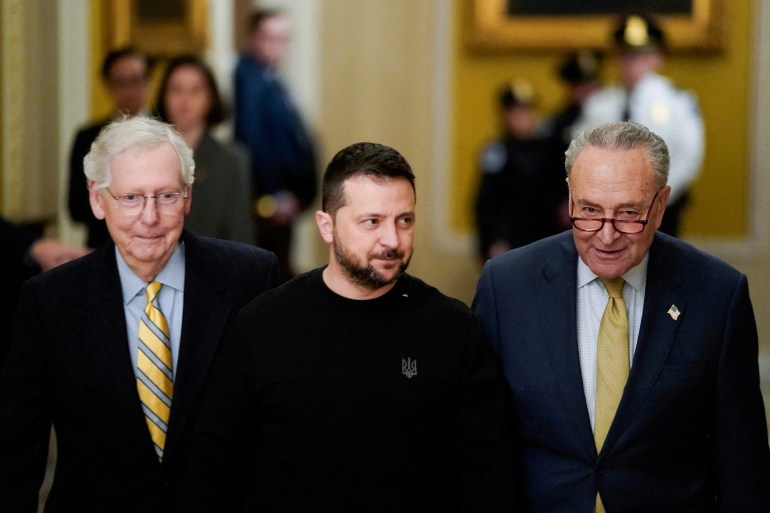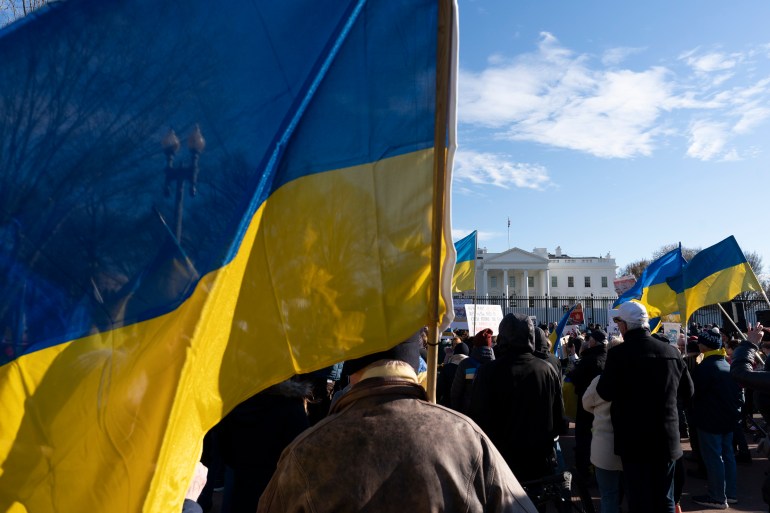Two years after Russia invaded Ukraine, Americans’ help for the warfare is waning, making a shocking alliance between the political left and proper.
Forty-one % of Americans instructed Gallup pollsters three months in the past that the United States is spending an excessive amount of to help Ukraine on the battlefield. That compares with 24 % of Americans who felt equally in August 2022, six months after the beginning of the warfare. Perhaps most shocking, although, is that the shift is most pronounced amongst Republicans, the political celebration that has traditionally been recognized for its hawkishness.
In March 2022, 9 % of Republicans believed the US was supplying Ukraine with an excessive amount of army help; by December final 12 months, 48 % of Republicans stated their authorities was spending an excessive amount of on Ukraine, based on Pew Research Centre surveys. The share of Democrats who view the Biden administration’s spending on Ukraine as extreme is barely 16 %, based on the identical December ballot.
To make certain, partisan politics shapes the rift in Washington with Republicans within the House of Representatives refusing to cross laws that features $60bn in army help for Ukraine. Republican House Speaker Mike Johnson has stated the invoice handed by the Democratic-controlled Senate doesn’t do sufficient to guard the southern border from immigration, a stance that bolsters Donald Trump’s presidential marketing campaign towards incumbent Joe Biden.

And Representative Marjorie Taylor Green leads a gaggle of staunch conservatives in Congress who’ve persistently opposed US funding for Ukraine. Still, a variety of liberals, resembling the author Glen Greenwald and the podcaster Jimmy Dore, have joined conservatives, resembling media presenter Tucker Carlson, in questioning the federal authorities’s priorities in spending billions on a distant warfare whereas the US has so many urgent wants, together with immigration, reasonably priced housing, healthcare and scholar debt reduction.
“The motivations for the far left and the far right are very different, but what unites them is where they arrive on Ukraine and also this anti-establishment populist strain,” stated Dominik Stecula, assistant professor of political science at Colorado State University
Republicans divided on Ukraine spending
While some within the Republican Party — like presidential candidate Nikki Haley and Senate Minority Leader Mitch McConnell — have a conventional nationwide safety focus harking back to the Cold War, the faction of the celebration that identifies with former President Trump’s political motion – MAGA, quick for his marketing campaign slogan Make America Great Again – is more and more rejecting Ukraine spending.
Isolationism has been a characteristic of Trump’s political message since 2016, defined Rachel Blum, an assistant professor within the University of Oklahoma’s Department of Political Science. “That is a really core thread of the MAGA movement.”
The white working-class voters who make up the majority of Trump’s supporters are animated by the sense that they’re being left behind in a shape-shifting economic system and cash that may be higher spent on their households goes to folks of color, the LGBTQ neighborhood and massive enterprise, together with defence contractors. These sentiments usually converge with racist, homophobic and transphobic beliefs.
Blum instructed Al Jazeera that Trump’s isolationism is of a selected kind that doesn’t essentially switch to different conflicts. “Trump is much warmer toward Israel than he is toward Ukraine,” she defined. “So I think a lot of it has to do with Trump’s very personal animosity toward Ukraine and [Ukrainian President Volodymyr] Zelenskyy and his past problems there and his affinity for [Russian President Vladimir] Putin.”

As the MAGA motion has strengthened its maintain on the Republican Party, she stated, “it’s not surprising that those sentiments are starting to spill over.”
Republicans are divided between those that keep in mind Cold War coverage and look at Putin, a former Soviet intelligence officer, as a risk and those that are inclined to blindly comply with Trump, she stated. In a Venn diagram, these two teams don’t overlap. “It’s hard for me to think of an example of a Republican who is pro-Ukraine aid and super supportive of Trump,” Blum stated.
As the November election attracts nearer, Blum stated Trump’s place because the presumptive nominee provides Republicans an incentive to oppose help to Ukraine to win favour with Trump if he returns to the White House.
Foreign coverage and the tradition wars
Numerous components performed pivotal roles within the Republicans’ shift towards Ukrainian help, stated David Hopkins, affiliate professor of political science at Boston College.
A generational divide is a part of the story. Older conservatives keep in mind the Cold War alliance between the US and Western Europe towards the Soviet Union whereas youthful conservatives don’t have reminiscences of the tensions between the West and the Soviet bloc, he stated.
Generally, Americans’ overseas coverage worldview is more likely to be influenced by authority figures they belief, together with politicians and media personalities, he stated. And conservatives are reflexively sceptical of insurance policies favoured by Democrats, resembling Biden’s help for Ukraine.
Moreover, Trump supporters’ sense of American exceptionalism extends to unfavourable views on Europe – which is seen as not wholly sharing the identical values because the US – and, consequently, NATO.
“They are open, just on the merits, to the argument that the US should be looking for ways to remove itself from involvement with European politics and alliances with international allies and organisations like NATO and the UN,” Hopkins stated.
Trump supporters are additionally open to viewing Putin as a traditionalist with comparable values to theirs. “Under Putin, Russia has advertised itself internationally as a bulwark of traditional Christianity,” Hopkins stated. “I think there are elements of the populist right in the United States that respond very positively to that message and indeed see figures like Putin as ideological allies in the culture war and international politics.”
Far proper and much left discover widespread floor
In a July 2022 piece for Foreign Policy, Stecula and co-author Jan Dutkiewicz argued that whereas nearly all of Americans supported help to Ukraine, many on the far proper and much left argued the US mustn’t intervene — an statement they defined with the “horseshoe theory”.
The principle comes from French thinker Jean-Pierre Faye, who believed excessive political positions aligned like a horseshoe magnet, which widens within the center earlier than practically converging at its prongs, Stecula defined.
On the far proper, there’s a heat towards authoritarianism, he stated. “I don’t think it’s a feature of conservatism, but it’s a feature of the Republican Party right now under Trump.”

He agreed with Hopkins that the populist proper is warming to Putin’s agenda, together with his anti-LGBTQ insurance policies. “He’s very well-versed in American culture wars. He talks about cancel culture. He talks about woke-ism all the time,” Stecula stated.
Meanwhile on the political left, the argument is that the Democrats have turn out to be step by step extra hawkish for the reason that Vietnam War in an effort to thwart Republican efforts, particularly by former President Ronald Reagan, to painting the celebration as mushy, and naive concerning the threats posed by communism. It will not be unusual, for example, to listen to progressives on in style podcasts specific their view that the Democrats have, in truth, turn out to be much more hawkish than the Republicans as a way of rewarding their Wall Street donors with windfall income that accrue from investments in arms suppliers resembling Lockheed Martin, Raytheon and General Dynamics.
Leftist writers and pundits contend that former President Barack Obama was essentially the most interventionist, hawkish president in US historical past, launching air strikes or fight operations in a minimum of seven international locations – Libya, Afghanistan, Iraq, Yemen, Syria, Somalia and Pakistan – and dramatically increasing the Pentagon’s army footprints in Africa. And whereas Trump enthusiastically embraced the wars he inherited from Obama, even progressives acknowledge that he didn’t begin any new wars, and he diminished the Pentagon’s army presence in Africa.
In a 2023 interview with then-Fox News host Carlson, the progressive Greenwald stated: “I’ve been asking since February, in what conceivable way will the lives of American citizens be materially improved? How will you or your family’s lives be protected or fostered by sending tens of billions of dollars, now in excess of $100bn, for the war in Ukraine?”
Another in style progressive, the YouTuber Dore, stated at an antiwar rally final 12 months: “We could have spent that money saving lives with universal healthcare, but instead, we spend that money taking lives overseas, which is our specialty.”
And Robert F Kennedy Jr, who’s in style with each the left and the proper within the US, introduced his 2024 presidential marketing campaign by contrasting the “$113bn committed to the Ukraine” with the “57 percent of Americans [who] can’t put their hand on $1,000 if they have an emergency” and the “one-quarter of Americans [who] go to bed hungry”.
Stecula attributed the convergence of the left and proper on the problem of Ukraine to a populist streak that has lengthy been current in US politics.
“They’re people on the fringes who reject the establishment, who are more anti-elite. And it’s a weird situation where people who are seemingly very different from each other can arrive at similar conclusions about what the US should be doing in regards to the conflict in Ukraine.”
https://www.aljazeera.com/news/2024/2/26/with-no-end-in-sight-to-conflict-with-russia-conservatives-and-progressives-say-no-to-more-military-aid-for-ukraine?traffic_source=rss


